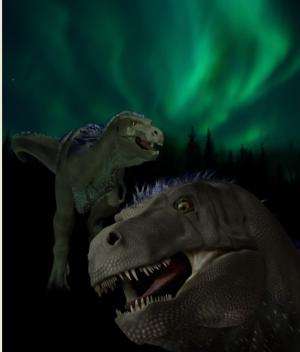Dinosaur skull may reveal T. rex's smaller cousin from the north

A 70 million year old fossil found in the Late Cretaceous sediments of Alaska reveals a new small tyrannosaur, according to a paper published in the open-access journal PLOS ONE on March 12, 2014 by co-authors Anthony Fiorillo and Ronald S. Tykoski from Perot Museum of Nature and Science, Texas, and colleagues.
Tyrannosaurs, the lineage of carnivorous theropod ("beast feet") dinosaurs that include T. rex, have captivated our attention, but the majority of our knowledge about this group comes from fossils from low- to mid-latitudes of North America and Asia. In this study, scientists analyzed the partial skull roof, maxilla, and jaw, recovered from Prince Creek Formation in Northern Alaska, of a dinosaur originally believed to belong to a different species, and then compared the fossils to known tyrannosaurine species.
According to the results of the authors' analysis, the cranial bones represent Nanuqsaurus hoglundi, a new tyrannosaurine species closely related to two other tyrannosaurides, Tarbosaurus and Tyrannosaurus. This new dinosaur is estimated to be relatively small, with an adult skull length estimated at 25 inches, compared to 60 inches for T. rex. The new species likely inhabited a seasonally extreme, high-latitude continental environment on the northernmost edge of Cretaceous North America. The authors suggest that the smaller body size of N. hoglundi compared to most tyrannosaurids from lower latitudes may reflect an adaptation to variability in resources in the arctic seasons. Further diversification may stem from the dinosaurs' partial isolation in the north by land barriers, such as the east-west running Brooks Range. Although the preserved elements of N. hoglundi are fragments, the authors point to morphological data to provide support for its place among derived tyrannosaurines. This discovery may provide new insights into the adaptability and evolution of tyrannosaurs in a different environment, the Arctic.
"The 'pygmy tyrannosaur' alone is really cool because it tells us something about what the environment was like in the ancient Arctic," said Fiorillo. "But what makes this discovery even more exciting is that Nanuqsaurus hoglundi also tells us about the biological richness of the ancient polar world during a time when the Earth was very warm compared to today."
More information: Fiorillo AR, Tykoski RS (2014) A Diminutive New Tyrannosaur from the Top of the World. PLoS ONE 9(3): e91287. DOI: 10.1371/journal.pone.0091287
Journal information: PLoS ONE
Provided by Public Library of Science





















